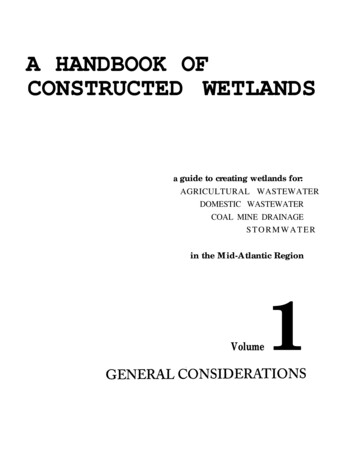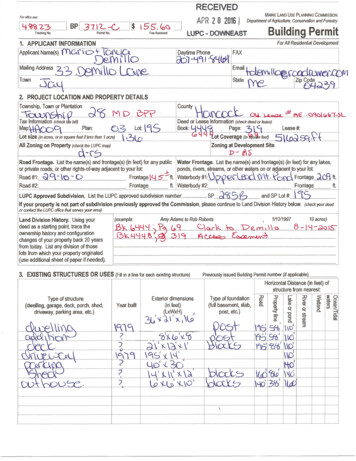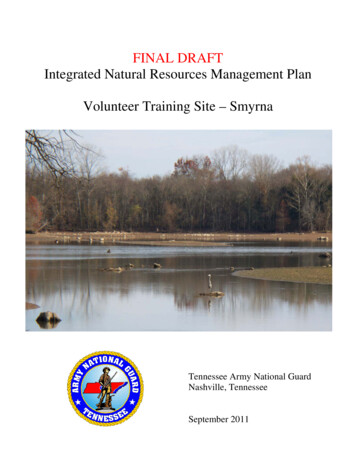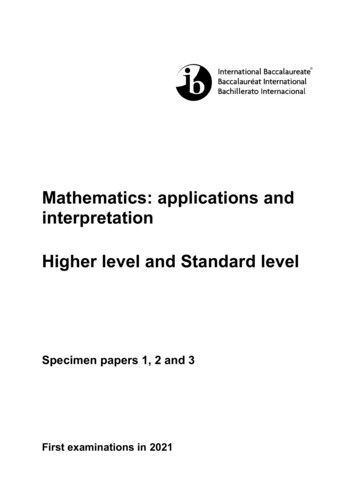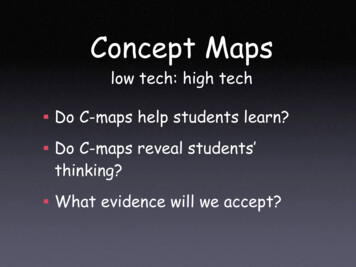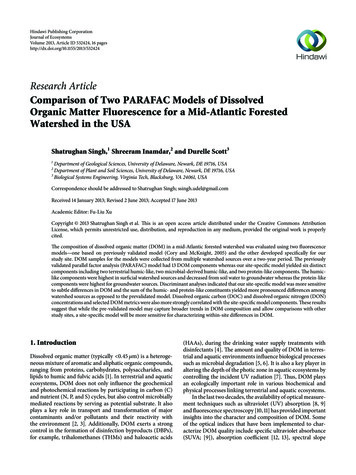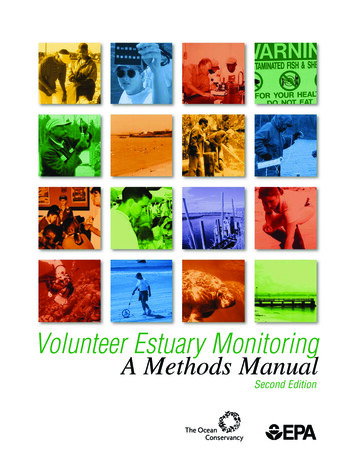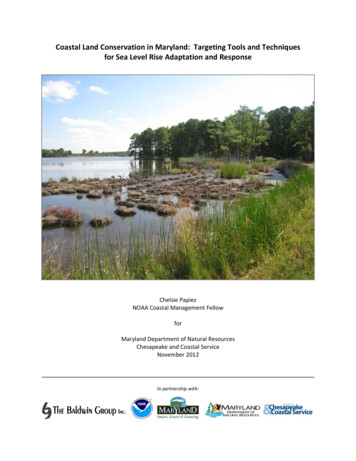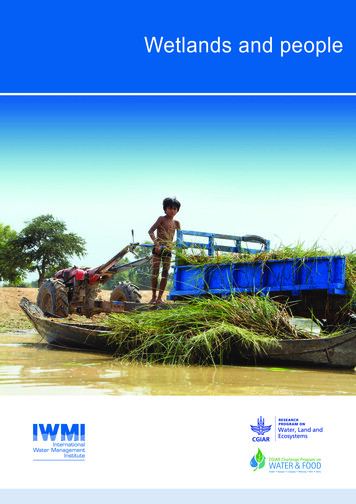
Transcription
Wetlands and people
Wetlands and people
Contributors:Matthew McCartney, Principal Researcher – Hydrologist and Office Head, IWMI, Vientiane, Lao PDRSanjiv de Silva, Researcher – Institutions Analyst, IWMI, Colombo, Sri LankaLisa-Maria Rebelo, Senior Researcher – Remote Sensing and GIS, IWMI, Vientiane, Lao PDREmma Greatrix, Program Manager, CGIAR Research Program on Water, Land and Ecosystems (WLE),IWMI, Colombo, Sri LankaEveristo Mapedza, Researcher – Social and Institutional Scientist, IWMI, Pretoria, South AfricaSylvie Morardet, Senior Economist, Institut national de recherche en sciences et technologies pourl’environnement et l’agriculture (IRSTEA), Joint Research Unit (G-EAU), FranceClément Murgue, PhD student, INRA (Institut National de la Recherche Agronomique) - UMR AGIR, FranceAndrew Noble, Program Director, CGIAR Research Program on Water, Land and Ecosystems (WLE), IWMI,Colombo, Sri LankaInternational Water Management Institute (IWMI). 2014. Wetlands and people. Colombo, Sri Lanka:International Water Management Institute (IWMI). 32p. doi: 10.5337/2014.202/ wetlands / natural resources management / ecosystems / river basins / dams / deltas / lakes /living standards / poverty / fish farming / rice / social aspects / economic aspects / income / case studies /Asia / Africa / Latin America / Niger / Nigeria / Zambia / Brazil / Cambodia / India /ISBN 978-92-9090-784-8Copyright 2014 by IWMI. All rights reserved. IWMI encourages the use of its material provided that theorganization is acknowledged and kept informed in all such instances.Cover image: Gathering reeds from Tonle Sap, Cambodia. Sanjiv de Silva, IWMIBack cover: Houses on Tonle Sap, Cambodia. Sanjiv de Silva, IWMIWriting and design by Green Ink: www.greenink.co.ukAvailable online at: etlands-and-people.pdfii
Wetlands and peopleAcknowledgementsThis booklet draws on research of numerous IWMI researchers and partners (past and present)whose invaluable contribution is gratefully acknowledged.This work has been undertaken as part of the CGIAR ResearchProgram on Water, Land and Ecosystems. IWMI is a member ofthe CGIAR Consortium and leads this program.The CGIAR Research Program on Water, Land and Ecosystems (WLE) combines the resources of11 CGIAR centers, the Food and Agriculture Organization of the United Nations (FAO) and numerousinternational, regional and national partners to provide an integrated approach to natural resourcemanagement research. WLE promotes a new approach to sustainable intensification in which ahealthy, functioning ecosystem is seen as a prerequisite to agricultural development, resilience of foodsystems and human well-being. This program is led by the International Water Management Institute(IWMI) and is supported by CGIAR, a global research partnership for a food secure future.Learn more at:Website: wle.cgiar.orgAgriculture and Ecosystems Blog: wle.cgiar.org/blogsThis work has been undertaken as part of the CGIAR ChallengeProgram on Water and Food (CPWF).Funding for the research carried out in this report was provided by the following organizations, amongothers, through the CGIAR Challenge Program on Water and Food (CPWF).UK Department for International Development (DFID)European CommissionEnabling poor rural peopleto overcome povertySwiss Agency for Developmentand Cooperation (SDC)International Fund for Agricultural Development (IFAD)Swiss Agency for Development and Cooperation (SDC)State Secretariat for Economic Affairs (SECO)The views expressed herein do not necessarily reflect the official opinion of DFID, EuropeanCommission, IFAD and SDC.iii
Wetlands and peopleWetlands and peopleContentsWhat are wetlands?2Wetlands and society3The Ramsar Convention on Wetlands3Why are wetlands important?4Threats to wetlands6The impacts of dams in the Nile BasinWetland agriculture78Improving livelihoods in the Inner Niger Delta9Calculating the agricultural potential of wetlands10Escaping poverty through wetland agriculture10Competing demands for wetland agriculture11Multiple uses of the Lake Chilwa wetland11People-centered wetland managementRice-fish farming in CambodiaLimits to wetland useGenerating income from wetlandsChanging attitudes to conservation and developmentDiffering perspectives on Ramsar designation in ZambiaTrade-offs12131415161718Threats outside the wetland18Successful wetland management in Brazil19Mapping wetlandsAgriculture in the Nile Delta2020Integrating conservation and development21The political economy of wetlands22Balancing needs in Kolleru LakeLocal involvement in wetland managementEvaluating wetland management options in Ga-Mampa232424Conclusion25Bibliography261
What are wetlands?There are many different types of wetland. TheseWetlands play a vital role in the hydrological cycle.include areas of marsh, fen, peatland and shallowThey are natural harvesters of rainwater, acting aswater bodies. Most are natural but some are human-sinks into which surface water and/or groundwatermade, and they can be permanent or seasonal. Theflows from the surrounding catchment.3 Wetlandswater in wetlands can be flowing or static, and canstore this water for varying amounts of time. Somebe fresh, brackish or saline. Marine water that doesreplenish groundwater and some regulate river flows.not exceed 6 meters depth at low tide is also classedSome also clean water, removing pollutants andas a wetland, and many river estuaries are globallysediment. However, not all wetlands perform all thesesignificant wetlands.environmental services. The exact role they playDespite this definition, modified from the RamsarConvention on Wetlands (1971), there are differentincluding the type and location of the wetland.interpretations of what constitutes a wetland aroundWetlands should be studied as part of widerthe world. Measurement and mapping techniques alsohydrological systems and basins. The water in avary between countries and regions. This makes itwetland is influenced by activities upstream, and thedifficult to accurately measure the number and extentuse of water in a wetland has an impact on the waterof wetlands globally. According to two estimates,1quality and quantity downstream. For example, highwetlands cover between 125 and 131 million hectaresrates of extraction for agricultural use will affect the(Mha) in Africa and between 204 and 286 Mha in Asia.amount of water flowing out of a wetland, not just theOverall, scientists estimate that wetlands cover atamount in the wetland itself. It is essential to considerleast 6% of the world’s land area. In South America,these flows when determining management optionsthe best estimate is approximately 179 Mha.for wetlands.2Mekoro polers in Botswana. Karin Duthie, Africa Media Online1232depends on a wide range of site-specific features,Higher figures from Lehner and Döll 2004; lower figures fromFinlayson et al.1999Finlayson and D’Cruz 2005McCartney et al. 2010
Wetlands and peopleWetlands and societyWetlands typically offer a wide variety of benefitsbut is a vital resource for the surrounding communitiesto society and they have played a central role in(see ‘Evaluating wetland management options inhuman development throughout history. Many greatGa-Mampa’, page 24).4 Cumulatively these smallcivilizations depended on them, including the Maya,wetlands play a significant role in reducing povertyInca and Aztec in Latin America, the Khmer in Asia,and supporting both livelihoods and biodiversity.the Marsh Arabs in Mesopotamia and those of the Nileand Niger in Africa.Today, some of the world’s largest wetlands arewell known. The Okavango Delta in Botswanaand the Pantanal in Brazil are famous for wildlifetourism; the Nile Delta in Egypt, the Ganges Deltain India and Bangladesh, and the Mekong Deltain Vietnam, although all heavily modified, supportglobally significant agriculture as well as other humanactivities.But smaller, less well-known wetlands are alsoenormously important, acting as a source of foodand water for people living nearby. For example, theGa-Mampa wetland in South Africa is only 0.43 km2,Grazing livestock in a wetland in Ethiopia. Matthew McCartney, IWMIThe Ramsar Convention on WetlandsThe destruction of wetlands has led to several initiatives to protect and restore them. The most significantof these is the Ramsar Convention on Wetlands. Established in 1971 in Iran, the Ramsar Convention onWetlands initially aimed to conserve wetland ecosystems, in particular for their importance as a habitat forbirds.Since then, the Ramsar Convention on Wetlands has shifted focus; it now seeks to protect wetlands notonly for their value to wildlife, but also for the benefits they provide for humans, particularly people livingin poverty. This is a key aspect of the principle of ‘wise use’ that the Ramsar Convention on Wetlandsadvocates.Signatories to the Ramsar Convention on Wetlands are obliged to designate at least one wetland intheir country as protected – this is added to the Ramsar List of Wetlands of International Importance. Inaddition, they are obliged to promote the wise use of all the wetlands in their territory, including those thathave not been designated as Ramsar sites. The most recent signatory was South Sudan in 2013.Source: www.ramsar.org4Morardet et al. 20133
Why are wetlands important?For centuries, people in Europe saw wetlands asthe structure and inter-relationships between itsunproductive land: difficult to access, difficult to farm,biological, chemical and physical components.5 Theseand the source of disease and flooding. But attitudescan be classified into four broad groups: provisioninghave changed; wetlands are now widely recognizedservices, regulating services, cultural services andas valuable due to the diverse services they provide,supporting services.6 Table 1 presents some examples.especially to poor people, and the biodiversity thatThe different types of services can be closely linked.they support.For example, provisioning services may be linked toTo a large extent, the services that a wetland providescultural services where people attribute spiritual valuestem from its biodiversity and its ‘ecological character’ –to the products that they obtain from wetlands.Table 1. Wetland servicesServicesComments and examplesProvisioning Food Production Freshwater Storage Fibersand fuel Productionand retention of water for domestic, industrial and agricultural use;supply of drinking water Biochemicals Extraction Genetic Genesmaterialof fish, wild game, fruits and grainsof logs, fuelwood, peat and fodderof medicines and other materials from flora and faunafor resistance to plant pathogens, ornamental species, etc.Regulating Climate regulation Source Water Groundwaterflows)regulation (hydrological Waterpurification and wastetreatmentand sink for greenhouse gases, including carbon; influence on local andregional temperature, precipitation and other climate processes Retention, Erosionregulation Retention Naturalhazard regulation Floodrecovery and removal of excess nutrients and other pollutantsof soils and sedimentscontrol and storm protection Pollination HabitatCultural Spiritual and inspirationalecosystems Source Recreational Opportunities Aesthetic Many Educational OpportunitiesSupporting Soil formation Sediment Nutrient Storage,cycling Biodiversityrecharge/dischargefor pollinatorsof inspiration; many religions attach spiritual and religious values toaspects of wetlandfor recreational activities, such as wildlife tourismpeople find beauty or aesthetic value in aspects of wetland ecosystemsfor formal and informal education and trainingretention and accumulation of organic matterrecycling, processing and acquisition of nutrients Wetlandsare highly productive and provide a wide range of ecological niches,supporting extensive biodiversityAdapted from: Wood et al. 2013a; McCartney et al. 2010; Millennium Ecosystem Assessment 2005564Ramsar Convention on Wetlands 1996Wood et al. 2013a; Ramsar Convention on Wetlands/FAO/IWMI 2013;Atapattu et al. 2010; McCartney et al. 2010
Wetlands and peopleProvisioning services are perhaps the most significantAssessing the economic value of wetlands isin terms of sustaining fundamental human needs,complicated. Many of the services they provide, suchreducing poverty and supporting people’s livelihoods.7as storing carbon, are a ‘public good’ and difficult toEven the smallest wetland can be a vital resource formeasure in financial terms. A crude estimate of thepeople living nearby, providing water for themselves,global value of wetlands is US 70 billion a year.9their crops and livestock, or a source of food and fish.These can be life-saving ‘safety nets’ in arid and semiarid regions, often being the only source of water andfood in the dry season.There is stronger evidence of the role that wetlandsplay in some developing country economies. InZambia, for example, wetlands are estimated tocontribute around 5% of gross domestic productHowever, while wetlands support livelihoods, they(GDP).10 They often support the poorest people indo not exist to ‘serve’ people. And as well as thea region, so their economic benefits are often morebenefits they offer, there are also dis-services. Forsignificant than a simple measure of their contributionexample, malaria may be enhanced in and aroundto GDP might imply. For example, in Tanzania’swetlands, particularly those that are degraded.Kilombero Valley, wetlands contribute up to 80% ofHowever, it is widely argued that these risks are lowercash income for the poorest households.11 Wetlandsin healthy wetlands that provide a habitat not only foralso help to address the root causes of poverty, suchmosquitoes, but also their predators.as poor nutrition and a lack of clean water.8Three female workers take a lunch break on a salt farm on Sambhar Salt Lake, India. iStock.com/Iryna Rasko789Millennium Ecosystem Assessment 2005Chase and Knight 2003Schuyt and Brander 200410 Wood et al. 2013a11 McCartney et al. 20105
Threats to wetlandsWetlands are dynamic ecosystems, changing naturallyextraction of water for intensive agriculture. Fertilizers,over time as a consequence of processes such aspesticides and other agrochemicals can pollute theerosion, sedimentation and coastal flooding. However,water in a wetland.13human activities, either within the wetland or in thecatchment in which they are situated, can alter thesenatural processes and accelerate the rate of change,threatening the wetland’s continued existence.While the farmers within a wetland are often the focusof attention for those seeking to protect wetlands,agricultural practices upstream also affect the qualityand quantity of water flowing into them. For example,While threats vary between regions and even withinupstream irrigation projects and extraction forwetlands, agriculture is considered to be the mostagriculture can reduce the flow of water to a wetland.significant. This is partly due to the scale of wetlandAgricultural practices may also increase surface runoffagriculture, which has increased dramatically in recentand soil erosion, thereby increasing the amount ofyears and damaged wetlands across the world. Butsediment entering a wetland. Wetlands should beit is also due to its nature: many wetlands have beenconsidered as part of larger landscapes (e.g. a basin)extensively and irreversibly modified as humans try towhen examining agriculture–wetland interactions.increase agricultural productivity.These threats are likely to grow in the next fewOne of the main impacts is disruption to wetlanddecades, as populations rise and demand more foodhydrology. Many have been drained so that the landand greater economic development.14 Nor is this threatcan be used to grow crops, including biofuels – 12confined to developing countries; many developedMha of peatland have been drained in Southeastcountries face similar problems. For example, theAsia for palm oil production. Other impacts includeabstraction of groundwater in Spain’s Guadiana basindiverting water via irrigation canals and the over-has led to rivers and wetlands drying up.1512Although some countries have policies for wetlandmanagement, they are often influenced by the policiesof several different sectors. Agricultural policiesin particular have been a key driver of changes towetlands. In China, for example, government policiesto drive economic growth and increase food securityafter the Communist Revolution (1946–1950) led toan increase in agricultural production, as millions ofpeople moved to work on the land. In the Sanjiangwetland in Heilongjiang Province, this resulted in thearea of wetland declining from 5.36 Mha to 1.04 by6Sanjiang Plains, China. Sanjiv de Silva, IWMI2000.1612 McCartney et al. 201013 McCartney et al. 200514 Molden 200715 Ramsar Convention on Wetlands/FAO/IWMI 201316 McCartney et al. 2010
Wetlands and peopleAgriculture is not the only activity that damagescan also have extreme impacts on wetlands locatedwetlands. Populations around wetlands often growdownstream.quickly, leading to pressure on natural resources. Withglobal populations predicted to continue rising, humandemands on wetlands are likely to increase further.Large water infrastructure projects, such as dams,often pose a significant threat to wetlands because oftheir effects on hydrology (see ‘The impacts of dams inthe Nile Basin’, below). Other upstream interventions,urban development and water extraction for industryClimate change is also expected to escalate thepressure on wetlands. More variable rainfall couldaffect the natural replenishment of many wetlands,and coastal areas are already at risk of flooding fromsea-level rise; it is estimated that 22% of coastalwetlands could be lost by 2080.17 Mining is anotherthreat in some regions.The impacts of dams in the Nile BasinWetlands cover approximately 10% of the Nile Basin and support the livelihoods of millions of people.But these have been greatly affected by human activities, particularly the construction of dams. Whiledams offer benefits such as hydropower, and indeed create new artificial wetlands, they also have severenegative impacts.In Egypt, the Aswan High Dam has increased the amount of agricultural land and water availability(lengthening the agricultural year), and generates electricity through hydropower.18 But it has affected thequality and quantity of water flowing downstream.For example, the dam limits the amount of waterand nutrient-rich sediment reaching the Nile Delta,disrupting the natural fertilization of this wetland.19Further large infrastructure projects are beingconsidered in the Nile Basin, such as thecompletion of the Jonglei Canal, which will divertwater around the Sudd wetland. These needcareful planning, with policy-makers consideringthe impacts on water flows and wetland usersdownstream.Source: Rebelo and McCartney 2012Aswan Dam, Egypt. iStock.com/efrem17 Nicholls et al. 199918 Biswas 199219 Hamza 20097
Wetland agricultureMany types of wetland are highly suitable forwetlands. As a result they introduced drainage andagriculture, and have been used for agriculture forinadvertently caused erosion.thousands of years, especially riverine wetlands infloodplains.20 They provide a ready supply of water,are usually found in flat areas, and the regular inputof sediment and plant material means that many arenaturally fertile.In southern Africa, for example, many forms oftraditional smallholder agriculture in wetlands aremodified each year, depending on the changingmoisture conditions. When European farmers arrivedin southern Africa (from the 1600s onwards), theyWetlands are playing an increasingly significant role inthe agricultural output of many developing countries;48% and 66% of Ramsar-designated wetlands inAsia and Africa respectively are used for agriculture.22Some argue that in Africa wetlands represent a new –possibly the last – ‘agricultural frontier’.23Many different types of agriculture take place inwetlands: were attracted to the wetlands, which were easy tosubsistence crops, as well as more lucrative crops,plough and remained moist, even in the dry wintermonths.21 However, European farming systems tendedWetlands can be used for growing staplesuch as vegetables. Many pastoralists and livestock keepers depend onto be larger in scale and less adaptable, requiringthem as a source of water for their animals; reedssimilar soil moisture throughout the area of theand other plants are a source of fodder. Wetlandsare contributing to the development of the dairyindustry in Uganda.24 They provide a reliable supply of water for irrigatedcrops, for example rice paddies; in arid and semiarid areas, wetlands are often the only source ofmoisture. Many wetlands are used for fishing and some arealso used for aquaculture. Some wetlands are actually created, and theirecological character is largely determined, byagricultural practices. For example, rice paddiesRecession agriculture in the Bahi wetland, Tanzania. Lisa-Maria Rebelo, IWMI20 Ramsar Convention on Wetlands/FAO/IWMI 201321 Whitlow 199022 McCartney et al. 20108are considered to be wetlands, as are fish pondsconstructed to supplement incomes and diets.23 Dixon and Wood 200324 Nakangu and Bagyenda 2013
Wetlands and peopleImproving livelihoods in the Inner Niger DeltaIf managed carefully, agriculture can thrive in wetlands and be sustainable. Through a range of differentactivities, the Inner Niger Delta (also known as the Macina) in Mali plays a central role in improving thelivelihoods of many of the people living within it. The richness of the floodplain soils enables farmers to grow rice, millet, maize and wheat. A small vegetable garden produces onions, tomatoes, eggplant and okra, improving nutrition in localhouseholds.25 The delta supports around 2 million cattle and 3 million sheep, some of the highest livestock densitiesin Africa. Around 300,000 people earn a living from fishing in the delta, although yields vary from 40,000 to 80,000tonnes a year.Agriculture is under threat, however; upstream dams and irrigation schemes have affected the magnitudeand timing of seasonal floods, which play a part in many of these systems. These have already reducedrice harvests by up to 15% and fishing by 18%.Source: Zwarts et al. 2005Livestock feeding at a wetland in Mali. Sanjiv de Silva, IWMI25 Wetlands International 20099
Calculating the agricultural potential of wetlandsPolicy-makers and governments often considerdevelopment pressures on it. These are analyzedagriculture to be the most productive potential use ofto establish where a wetland lies on the scale, froma wetland – in turn making it the greatest threat – buthaving no potential for being used for agriculture, tothis needs to be assessed based on its characteristics.high potential. The results of the analysis can then beThe type and extent of agriculture depends on thefed into planning and management decisions.size, type and biophysical characteristics of eachwetland.Although not tested widely by IWMI, Working WetlandPotential has been cited as a useful approach by theIWMI developed the concept of Working WetlandUNESCO-IHE Institute for Water Education. It hasPotential as a way to evaluate the potential valuealso been proposed for inclusion in a study to provideof individual wetlands, in terms of their economicscience-based guidelines, tools and policy advicevalue from agriculture and the environmental servicesfor the sustainable use of wetlands in East Africa. Itthey provide, which can be difficult to quantify. Usingremains a potentially useful tool for establishing themulti-criteria analysis, this approach attempts tovalue of wetlands, in terms of economic benefits forsimplify the many complex factors associated withlocal people and the wider environmental servicesbalancing the multiple uses of a wetland: its ecologicalprovided.26condition, its contribution to social welfare, and theEscaping poverty through wetland agricultureCecilia Pensulo, from Mpika District in Northern Zambia, struggled to support herself and her four children onher irregular income from farm laboring. To increase her income, she decided to start farming herself in thedambo – a type of seasonal wetland – near her village.With help from a local non-governmental organization, Cecilia learned new farming methods to make thispreviously unused land productive. In her first year, she only developed a small area, but the crops weregood and the prices she got were high. In her second year, she cultivated 0.25 hectares, growing pumpkins,squashes and tomatoes. She sold the crop to traders and managed to make the equivalent of over US 200 –a small fortune by local standards.Cecilia invested some of her profits in chicken rearing. The chickens are sold every 3 to 4 months, earning aprofit of approximately US 300 each time. Her wetland farming is still ongoing, but is less intensive now thatshe has diversified. However, she says that she will never give up dambo cultivation as it provides her familywith food during times of scarcity.Through these varied activities, Cecilia is able to meet all her household costs and has enough income to sendher children to school. She is now a respected member of her community and was elected as the secretary forthe community school. Dambo cultivation not only fed her family, but helped her have a voice in her community.Source: Sampa 200826 McCartney et al. 2005; McCartney et al. 201010
Wetlands and peopleCompeting demands for wetland agricultureWhile the potential for agriculture varies betweenFor example, the Kalametiya coastal lagoon in Sriwetlands, it also varies between different sectors of aLanka is used for rice production and fishing. Butcommunity. In some places, wetland agriculture onlychanges to the lagoon have increased competitionbenefits a small number of people, while the very poorestbetween rice paddy farmers and fishermen. Bundspeople feel the negative consequences most heavily.(barriers) built to prevent the paddy fields flooding,27Poor people can also lose out to large-scaleagricultural interests; if agriculture in a wetland isintensified, it can demand a greater amount of wateror land. Those depending on the wetland for smallscale or subsistence agriculture or other uses caneasily lose out. Not only must agricultural potential bebalanced against ecosystem services and biodiversityconservation, but also the competing demands foralong with an outlet built to channel irrigation water tothe sea (rather than the wetland), have reduced theflow of water to the lagoon, leading to a decrease inits size. This has resulted in a drastic decline in thenumber of people able to earn a living from fishing.The fishers want to see the bunds destroyed and theoutlet channel blocked, but this would then affect riceproduction.28different types of agriculture must be factored in.Multiple uses of the Lake Chilwa wetlandLake Chilwa, the second-largest lake in Malawi, is surrounded by wetlands that cover 2,248 km2. Thewetland, which is a Ramsar site, is a mix of reed swamp, marsh and floodplain grassland. The lakesupports around 1.5 million water birds, with about 160 different species present.29The Lake Chilwa catchment has one of the highest population densities in the country, with approximately162 persons per km2 (the national average is 104 persons per km2). It is an important source of livelihoodfor over a million people and supports a wide variety of activities, including fishing, agriculture and huntingwater birds.It is one of the most productive lakes in Africa in terms of fish, typically providing 20% of the country’s totalfish catch (and up to 43% in some years).30 Fishing takes place year-round in the area of permanent openwater. The floodplain is used for fishing during the wet season and for small-scale rice growing as floodlevels recede. During the dry season, this area is predominantly used for grazing and growing vegetables.Other parts of the wetland are also used to grow rice. In the 1970s several large-scale irrigation schemeswere established in the wetland, to grow high-yielding rice varieties. These produce 50% of all the ricegrown in Malawi.Overall, the economic value of the wetland is estimated to be US 212 million per year.31 However, as thelake has no outlet, water levels are greatly affected by seasonal rains and summer evaporation. Thereare concerns about the effects on food security if the lake dries up completely in the future: it dried upnine times in the 20th century due to low rainfall, and climate change is likely to increase the variabilityof rainfall in the catchment.32 An integrated management plan needs to be developed to ensure thesustainability of its many uses in the future.27 Woodhouse et al. 200028 McCartney et al. 201029 http://en.wikipedia.org/wiki/Lake Chilwa30 Jamu et al. 200631 Schuyt and Brander 200432 Environment News Service 2012; WorldFish n.d.11
People-centered wetland managementAlthough wetlands have traditionally been protected forwhile simultaneously protecting vital ecosystemtheir value to wildlife and the environment, policy-makersservices – is essential if wetlands are to be conservedand conservation groups are increasingly recognizing thefor future generations.34role that these areas play in supporting rural livelihoodsand reducing poverty. Millions of people directly dependon wetlands for their livelihood, and these are often thepoorest groups in society. This figure includes: around1.5 million in the Hadejia-Nguru wetland in Nigeria; morethan 1 million in the Sudd wetland in South Sudan; 1million people near Lake Chilwa in Malawi; and 300,000in the Inner Niger Delta in Mali.33Ensuring wetlands are used sustainably will ensurethat poor people can continue to obtain the benefitsthat wetlands provide, and is therefore essential forr
iii Wetlands and people Acknowledgements This booklet draws on research of numerous IWMI researchers and partn
